ABSTRACT
Background
Wound healing is a complex physiological process that involves a cascade of events, from inflammation to tissue remodeling. Impaired wound healing can lead to chronic wounds, which are painful and susceptible to various infections, including fungal ones. Candida and Cryptococcus infections are particularly troublesome due to their resistance to conventional treatments. In this context, hydrogels have emerged as promising drug delivery and wound management vehicles.
Materials and Methods
The hydrogel, made from 5-flucytosine, chitosan, and pectin, provides a moist environment for wound healing and creates a barrier against infections. In this study, four hydrogel formulations containing 5-FC, chitosan, pectin, and 0.1 M HCl were developed and. they were optimized for various parameters, including drug concentration, polymer ratio, and crosslinking density. Dependent variables maximize drug release, gel stability, and other desired properties. Hydrogel Base includes natural and synthetic material that exhibits desirable properties, such as high water absorption capacity and gel stability.
Results
Formulations evaluated for their compatibility, Physical properties, Spreadability, Viscosity, Rheological studies, pH, Ex vivo Skin Permeation Study, Structural and Morphological Analysis, Swelling Index, Anti-fungal Activity Studies, the hydrogel’s effectiveness against C. albicans was demonstrated in an experiment, with the F-3 formulation showing the most effective anti-fungal properties.
Conclusion
The 5-FC hydrogel presented a significant step towards addressing the challenges posed by chronic wounds and fungal infections.
INTRODUCTION
Hydrogels
Hydrogels are a type of material with various applications in engineering, biomedical, and pharmaceutical fields. One specific area of interest is their use in drug delivery and wound dressing due to the growing number of patients with acute or chronic wounds. This problem is illustrated by the increasing market size for wound dressings. Developing advanced wound dressings with multiple properties is important, such as absorption of fluids, protection of the injury, and promoting wound healing. Multifunctional advanced dressings in the form of superabsorbent hydrogels are being researched and should possess characteristics like porous structure for absorbing fluids, high swelling ratio, transparency for wound monitoring, and the ability to deliver bioactive molecules. These hydrogels can also be used to deliver therapeutic drugs or growth factors, as they can hold large amounts of bioactive molecules and release them at the targeted location through specific mechanisms. The challenge lies in finding the optimal formulation for hydrogels that can function both as a drug delivery system and wound dressing.
5-Flucytosine is a synthetic antimycotic compound that has been used since 1957. While it does not have direct antifungal activity, it is converted to 5-fluorouracil, which does have antifungal properties. The conversion process is facilitated by the enzyme cytosine permease. Once converted, 5-fluorouracil can be incorporated into RNA, inhibit the enzyme thymine methyl synthase, or affect nucleotide concentration. This antifungal activity is particularly effective against Cryptococcus neoformans but can lead to resistance in microbes like Candida albicans. Combining 5-flucytosine with amphotericin can enhance its effectiveness. Resistance to the drug can also be pH-dependent or due to down-regulation of specific genes. Additionally, 5-flucytosine can be converted to 5-fluorouracil by cytosine deaminase, which is shown in Figure 1. The antifungal drug 5-flucytosine does not have any antifungal activity on its own. However, once it enters a fungal cell, it is quickly transformed into a substance called 5-fluorouracil by an enzyme called cytosine deaminase. This transformation is what gives 5-flucytosine its anti-fungal properties. Researchers have also studied the direct use of 5-fluorouracil as a drug. However, its effectiveness has been limited by its low ability to be absorbed by the body and its high toxicity to mammalian cells.1–3
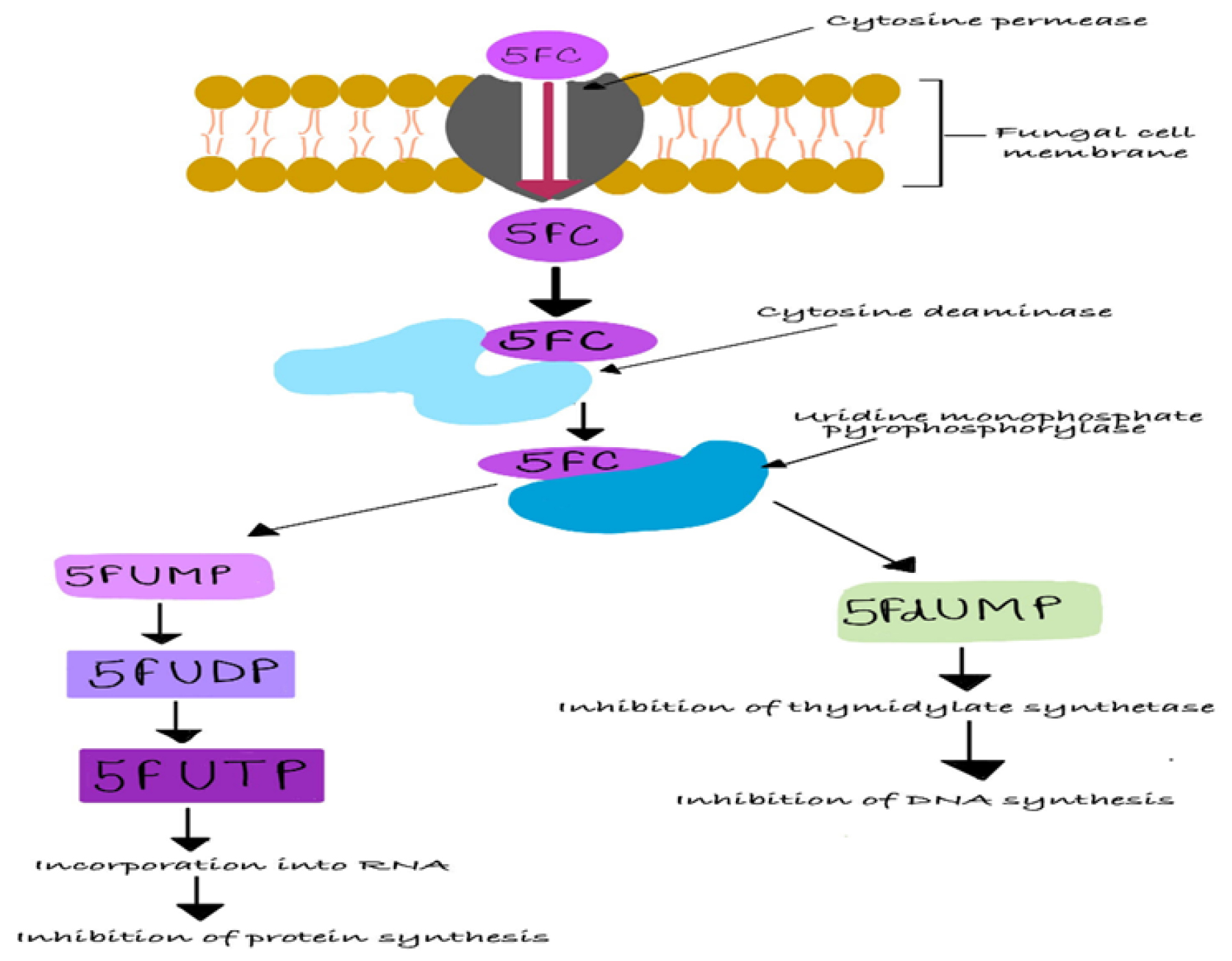
Figure 1:
Mechanism of 5-Flucytosine.
MATERIALS AND METHODS
Calibration curve of 5 flucytosine in 6.8 pH buffer
To begin the experiment, 50 mg of Flucytosine was accurately weighed and dissolved in 50 mL of methanol. From this solution, 1 mL was taken and diluted with phosphate buffer pH 6.8 in a 100-volumetric flask, resulting in a stock solution with a concentration of 10 μg/mL. Next, aliquots of 2, 4, 6, 8, 10, and 12 were withdrawn from the stock solution and further diluted with phosphate buffer pH 7.4 in 100 mL volumetric flasks. This process allowed for the creation of a concentration range spanning from 0.2 μg/mL to 1.2 μg/mL. To determine the absorbance of these solutions, a UV-spectrophotometer was utilized, measuring the absorbance at a wavelength of 288 nm.1–4
Method of Preparation
5 Flucytosine hydrogel was prepared by mixing polysaccharide solutions of PEC and CS in HCl at 65°C for 3 hr. The hydrogel samples were created by combining the PEC and CS solutions at a ratio of 1:4 at 65°C for 1 hr. For the 5 flucytosine-loaded hydrogel samples, 5 flucytosine was dissolved in the PEC solution before blending. The pH of the final solution was adjusted using 0.1 M NaOH. The hydrogel was then cut into smaller pieces, frozen, and lyophilized.3
Enhancing Hydrogel Performance
Physical Appearance and Homogeneity
The hydrogel formulations underwent a thorough visual inspection to assess their clarity, color, homogeneity, and the presence of any particles or fibers.5
Solubility
Typically, the hydrogel content of a specific material is determined by measuring the portion that remains insoluble after immersing a dried sample in deionized water for 16 hr. Preparing the sample at a low concentration (usually around 1%) is important to ensure complete dispersion of the hydrogel material in water. The gel fraction can then be measured using the following method:
In this context, Wi represents the initial weight of the dried sample, while Wd refers to the weight of the dried insoluble portion of the sample following water extraction.6
Viscosity and Rheological Studies
In order to assess the rheology of Linezolid in-situ gel, we utilized the Brookfield digital viscometer to measure the spindle number LC. The viscosity of the in-situ gel was determined at different angular velocities, specifically at 25°C. Our study involved a unique experiment where we observed changes in the angular velocity ranging from 10 to 60 rpm.7
Spreadability
To determine the spreadability of the hair gel formulation, two glass slides of standard dimensions were carefully chosen. The first slide served as the base, upon which the hair gel formulation was applied. The second slide was then placed on top, sandwiching the formulation between them along a 6 cm length.
To ensure an even distribution, a weight of 100 g was gently placed on the upper slide, causing the hair gel formulation to spread uniformly and form a thin layer. Once this was achieved, the weight was removed, and any excess formulation clinging to the slides was carefully scraped off. Next, the lower slide was securely fixed onto the apparatus board, while the upper slide was tied to a string. This string was connected to a simple pulley system, allowing a 2 g load to be applied. The purpose of this setup was to measure the time it took for the upper slide to travel the 6cm distance and separate from the lower slide, under the influence of the weight. By noting the time taken for this separation to occur, we can accurately determine the spreadability of the hair gel formulation.5
Where,
m=weight tied to the upper slide (2 g).
l=length of glass slide (5 cm).
t=time taken is seconds.
Measurement of pH
To measure the pH levels accurately, we prepared individual solutions with both acidic and basic pH values. This was achieved by diluting NaOH (with a pH of 13.0) and HCl (with a pH of 1.0) solutions to obtain pH levels of 6.0 and below 6.0, respectively. The pH values were meticulously verified using a pH meter. Next, we determined the pH of the hydrogel formulations we developed. This was accomplished by dissolving 1 g of hydrogel in 100 mL of distilled water and allowing it to sit for 2 hr. The pH of each formulation was measured three times to ensure accuracy, and the average values were calculated. By following this rigorous process, we were able to obtain precise pH measurements for our hydrogel formulations.8
Ex vivo skin Permeation study
Structural Analysis
In this study, rat skin was used to observe the diffusion of a drug over an eight-hour period. The skin was mounted in a diffusion cell, with the dermis side in contact with a buffer solution pH 6.8). The drug was applied to the stratum corneum, and the diffusion of the drug into the buffer solution was observed. Samples were taken at regular intervals (every hour) and analyzed for drug content. Permeation enhancers such as menthol, phospholipid 80H, and isopropyl myristate were used. The rate of skin permeation was measured as the flux, which was calculated from the slope of the linear part of each permeation profile.9
The FTIR spectra were recorded on dried samples in KBr pellets using a Bruker Vertex 70 spectrophotometer (Berlin, Germany) and scanned within the range 400-4000 cm-1 in transmittance mode.
Scanning Electron Microscopy (SEM)
Scanning Electron Microscopy (SEM) is a highly effective technique for studying samples’ surface topography, composition, and properties, including their ability to conduct electricity. It is beneficial for visualizing the network structure of hydrogels, which have important applications in biomedical engineering, drug delivery, and tissue engineering. SEM provides detailed information about samples’ surface features and composition, allowing for a better understanding of their properties and potential uses. Overall, SEM is a powerful tool that contributes to advancements in scientific and technological research.6
Swelling Index
The determination of swelling kinetics and equilibrium swelling ratio was conducted using a phosphate buffer solution with a pH value of 6.8. Prior to immersion in the buffer solution, the hydrogel discs in their dehydrated state were subjected to initial weighing. Following a designated time interval, the discs were extracted from the buffer solution, gently dried using butter paper to eliminate any residual surface moisture, and subsequently re-measured for weight. The measurement of swell patches was conducted utilizing an analytical balance. Research investigations were carried out to examine the phenomenon of swelling till the weight of the patches reached a state of equilibrium.10
Anti-fungal Activity Evaluation
To prepare the agar medium, 16.25 g of Sabouraud Dextrose Agar were carefully measured and transferred into a 500 mL conical flask. Next, 250 mL of filtered water was added to the flask, and the mixture was gently heated to ensure complete dissolution.
The prepared medium was then sterilized in an autoclave for approximately 20 min at a temperature of 121°C and a pressure of 15 pounds. Once sterilized, the medium was poured into three Petri dishes and allowed to cool at room temperature until it solidified.
To create wells in each Petri dish, a sterile steel bore with a diameter of 6mm was used. Gel Formulation (F3) was carefully placed in these wells. The Petri plates were then incubated in an incubator at a temperature of 37°C for duration of 72 hr.
After the incubation period, the zone of inhibition was observed and the radius of this zone was estimated.
By following these steps, we were able to prepare the agar medium, introduce the gel formulation, and observe the resulting zone of inhibition.4
RESULTS
Preformulation Study
Nature: The topical antifungal agent is widely used to treat severe human fungal skin infections, including Candida and Cryptococcus infections.
Taste: The drug has a bitter taste.
Melting Point: Melting point is determined by Karl fisher reagent method. The results were shown in Table 1.
| Drug | Melting Point | Normal Range |
|---|---|---|
| Flucytosine | 197.3±0.134 | 295-297°C |
Determination of Melting Point.
Solubility
The solubility of drug was performed by using various solvents system. The results were depicted in the Table 2.
| Sl. No. | Solvent System | Solubility (mg/mL) at 37±2°C |
|---|---|---|
| Diethyl Ether | 18 | |
| Chloroform | 85 | |
| Ethanol | 90 | |
| CCl4 | 82 | |
| Distilled H20 | 0.06 |
Solubility Profile of 5-Flucytosine.
Formulation
The final concentrations of 5 flucytosine in hydrogel were prepared as 1.5, 2, 2. 5, and 3% w/w and named, F-1, F-2, F-3, F-4 as shown in Table 3. The Hydrogel formulation has shown in Figure 2.
| Name of ingredients | Concentration | |||
|---|---|---|---|---|
| F-1 | F-2 | F-3 | F-4 | |
| Drug | 400mg | 400mg | 400mg | 400mg |
| Chitosan | 1.5% | 2% | 2.5% | 3% |
| Pectin | 1.5% | 2% | 2.5% | 3% |
| 0.1M HCl | 200 mL | 200 mL | 200 mL | 200 mL |
List of hydrogel formulations.
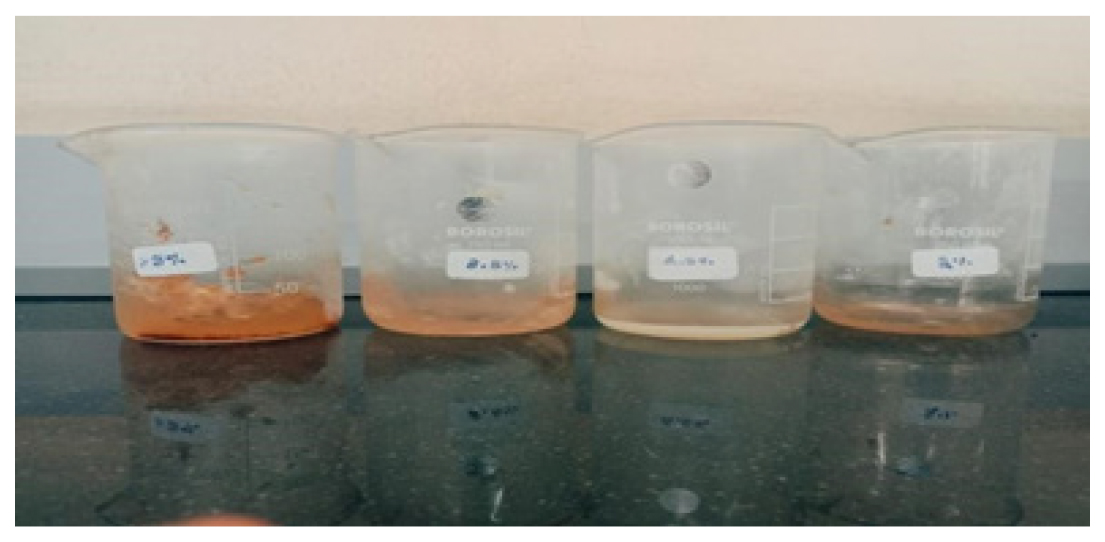
Figure 2:
Hydrogel Formulation.
Calibration curve of 5-flucytosine drug
The absorbance was determined by employing a UV spectrophotometer set at a wavelength of 260 nm while referencing it against a buffer solution with a pH of 6.8.The absorbance obtained was tabulated in Table 4, and the graph was plotted and shown in the Figure 3.
| Concentration μg/mL | Absorbance | |||
|---|---|---|---|---|
| 1 | 2 | 3 | Average | |
| 2 | 0.156 | 0.157 | 0.156 | 0.156 |
| 4 | 0.257 | 0.257 | 0.258 | 0.257 |
| 6 | 0.322 | 0.322 | 0.321 | 0.322 |
| 8 | 0.388 | 0.389 | 0.390 | 0.389 |
| 10 | 0.405 | 0.406 | 0.405 | 0.405 |
Spectrophotometric data for the estimation of 5-flucytosine in 6.8 PH buffer.
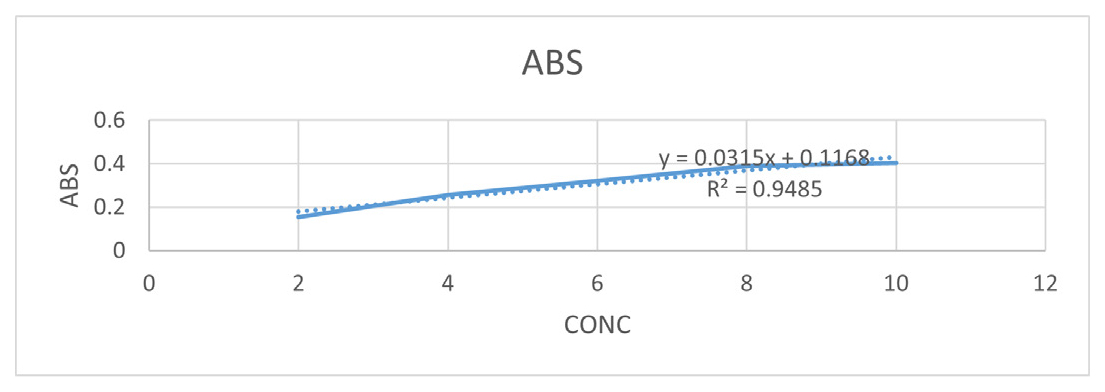
Figure 3:
Standard calibration curve of 5- Flucytosine.
FTIR
The peaks observed in the spectra of each formulation are in line with the peaks found in the drug spectrum. This suggests that the drug is compatible with the components of the formulation.
Below, you can find the spectra for all the formulations. The Infrared (IR) spectrum of the pure drug displays characteristic peaks at 1675 cm-1 and 3755 cm-1, which are attributed to C=O, C-F, C=N, C-N, and N-H bonds. Similarly, the formulations containing chitosan, pectin, and the optimized formulations also exhibit similar peaks for these functional groups. This confirms that the drug maintains its original structure within the formulations. All the FTIR graphs shown in Figure 4. Furthermore, there are no interactions between the drugs and excipients, indicating their compatibility with each other.
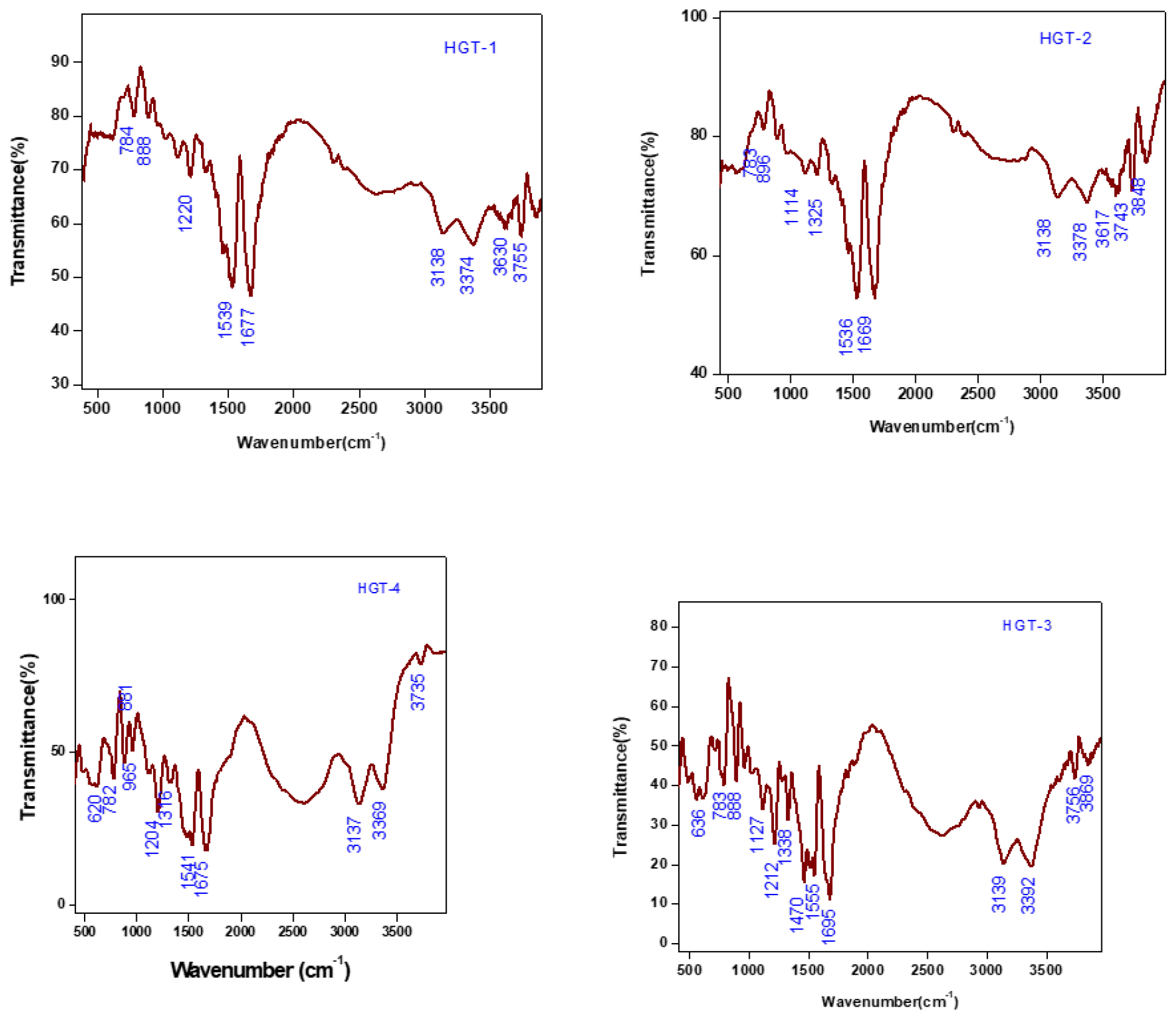
Figure 4:
FTIR graph a) IR spectrum of drug+chitosan+pectin b) IR spectrum of pure drug+chitosan c) IR spectrum of pure drug+pectin d) IR spectrum of pure drug.
Spreadability
The Spreadability of each hydrogel formulation was found to be in the range of 20-26 g. cm/sec which is within the acceptable range. The Spreadability of each formulation in mentioned in Table 5. The 2.5% Hydrogel shows optimum range so which is shown in the Figure 5.
| Formulation code | pH | Spreadability (g cm/sec) | Viscosity (cps) |
|---|---|---|---|
| F1 | 6.8 | 26.1 | 1073 |
| F2 | 6.8 | 23.3 | 2033 |
| F3 | 6.8 | 21.7 | 2733 |
| F4 | 6.8 | 20.2 | 5139 |
Results of physical parameters of all formulated 5-flucytosine hydrogels.

Figure 5:
Hydrogel formulation Spreadability.
Ex vivo Skin Permeation Study
The drug was applied to the stratum corneum, and the diffusion of the drug into the buffer solution was observed. Samples were taken at regular intervals (every hour) and analyzed for drug content. The graphs are depicted in the Figure 6. The F3 Formulation shows highest drug release of 96.3%.
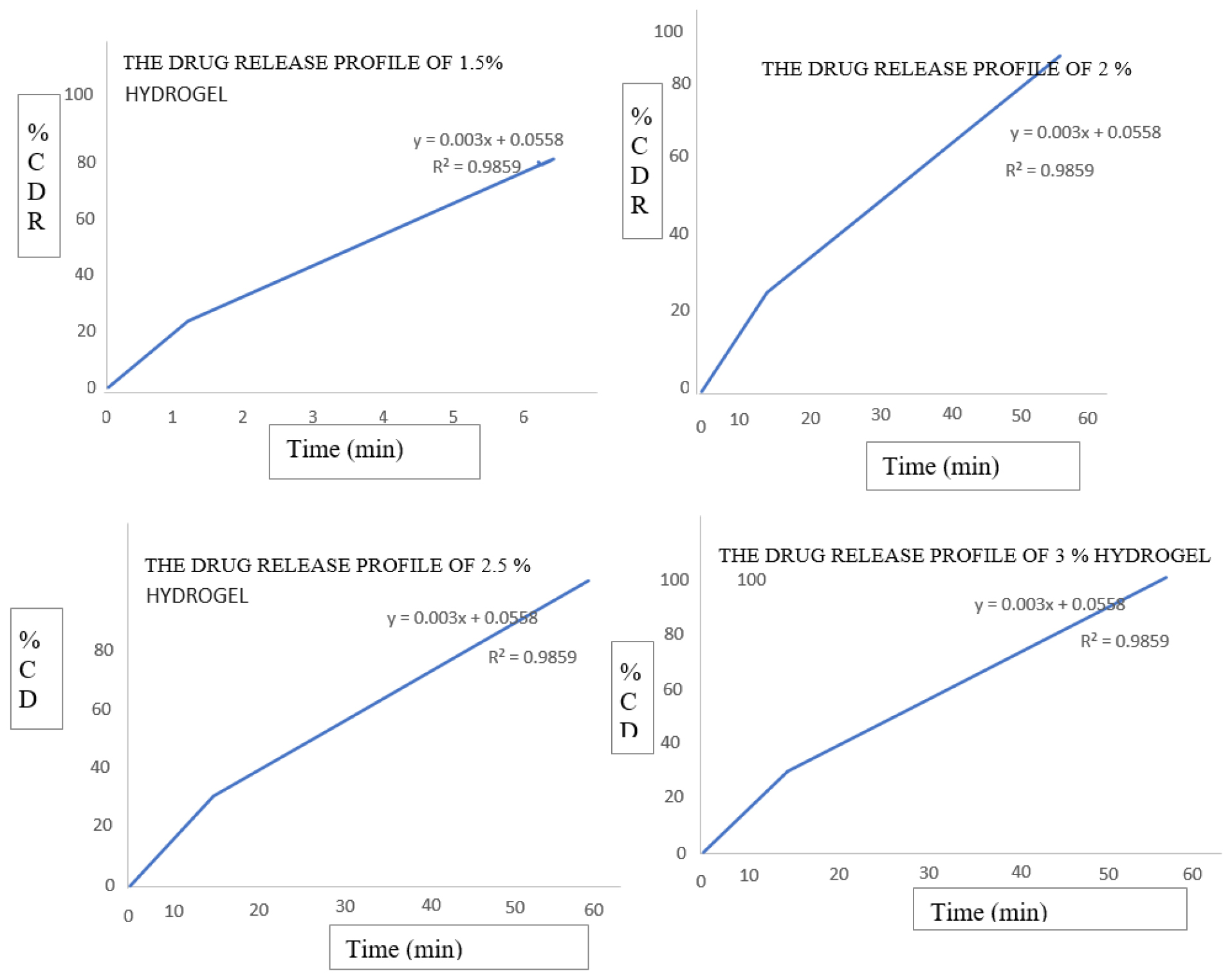
Figure 6:
Ex vivo diffusion study a) The Drug Release Profile of 1.5% hydrogel, b) The Drug Release Profile of 2% hydrogel, c) The Drug Release Profile of 2.5% hydrogel, d) The Drug Release Profile of 3 % hydrogel.
Scanning Electron Microscopy
In a 0.1 mol L-1 HCl solution, all amino groups on CS chains become ionized (NH3+) due to their pKa value of 6.5. On the other hand, Pec networks possess non-ionized sites (COOH) with pKa values ranging from 2.9 to 3.2. Consequently, the Pec segments fail to neutralize the charged amino sites, resulting in repulsion among them. This phenomenon leads to an increase in pore size, facilitating the formation of new tissues. As a result, cell migration, vascularization, differentiation, and proliferation are promoted, as these systems closely resemble the extracellular matrices of cells. The SEM of all formulation is shown in Figure 7.
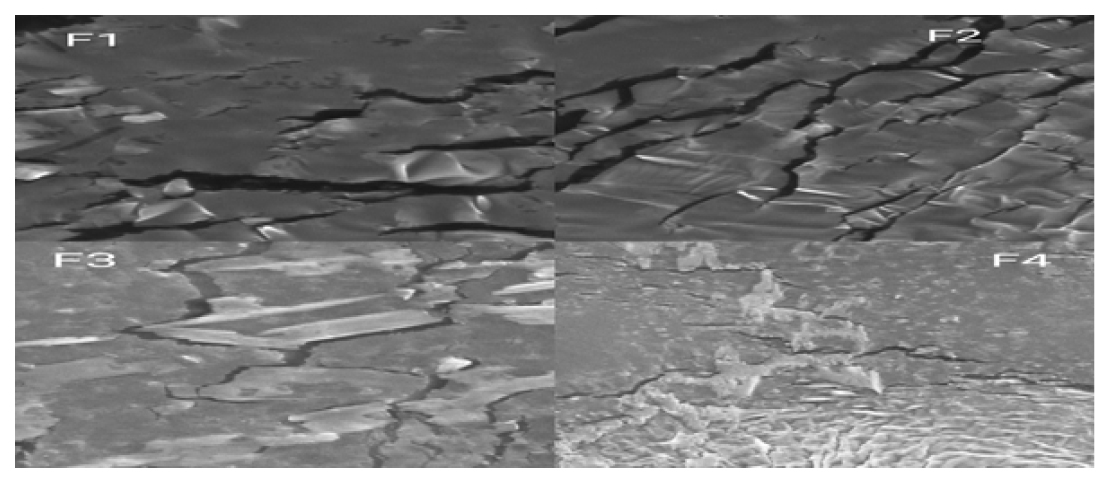
Figure 7:
The SEM images of the CS/Pec hydrogels are displayed.
Antifungal Activity Studies
The zone of inhibition test was done for fungi. Studies on anti-fungal properties have demonstrated positive outcomes for formulation F3, indicating its potential for effectively treating candida and Cryptococcus infections. The results for fungi are shown in Table 6 and Figure 8.
| Sl. No. | Formulation | Diameter of Inhibition (cm) | Zone of Inhibition (cm2) |
|---|---|---|---|
| 1 | F1 | 1.25 | 4.90 |
| 2 | F2 | 2.25 | 15.89 |
| 3 | Fз | 2.5 | 19.62 |
| 4 | F4 | 1.5 | 7.06 |
| 6 | STD | 1.65 | 8.54 |
Zone of inhibition for fungi.
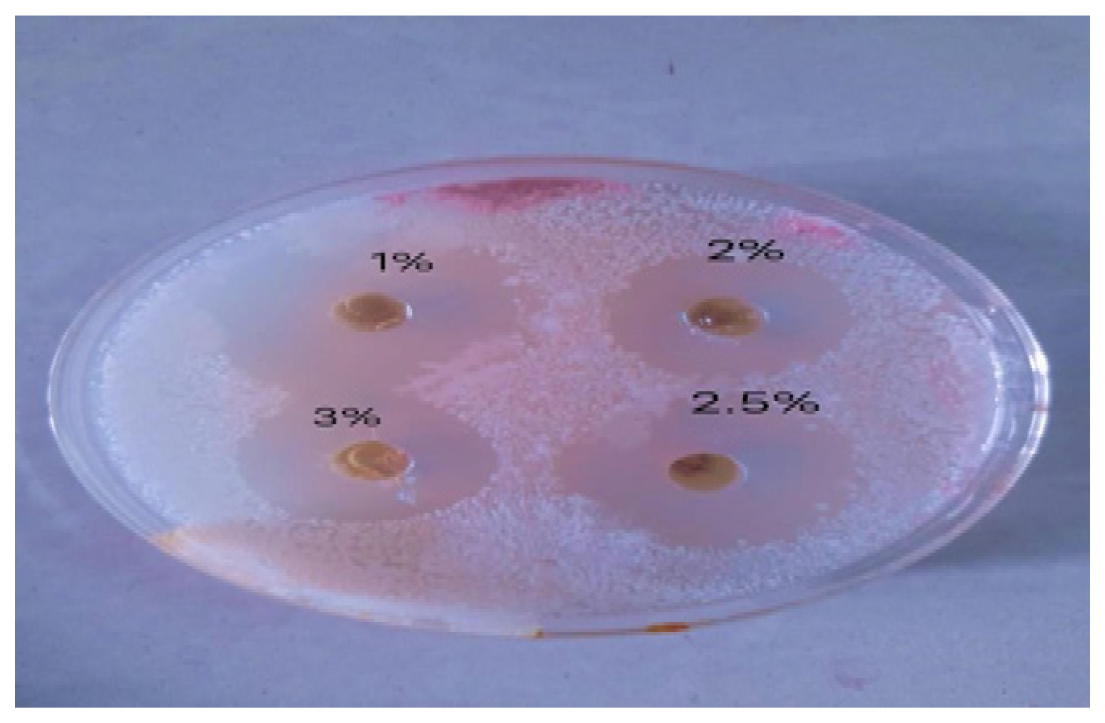
Figure 8:
Zone of inhibition for all the formulations.
Swelling Index
The hydrogel formulation was characterized by measuring its swelling index and released to determine the effect at pH 6.8. The optimized hydrogel formulation exhibited significant swelling and drug release at pH 6.8 is shown in Figure 9.
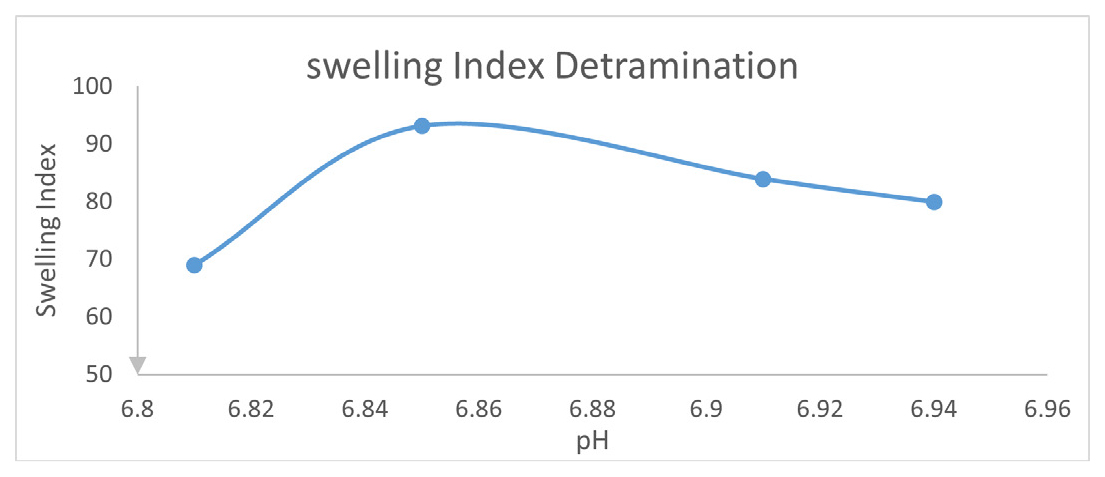
Figure 9:
Swelling index of prepared formulations.
DISCUSSION
The research focuses on the creation of a 5-flucytosine drug hydrogel. The solubility of the hydrogel was evaluated using several solvents, with ethanol having the maximum solubility. The spreadability of the hydrogel was determined to be within acceptable limits. Ex vivo skin penetration experiments revealed that the F3 formulation had the highest drug release rate of 96.3%. The hydrogel’s antifungal properties were investigated, with promising results for treating candida and Cryptococcus infections. The hydrogel’s swelling test performed, showing its safety for use.
CONCLUSION
The study aimed to prepare and evaluate a 5-flucytosine hydrogel containing the drug. The hydrogel was formulated with 2.5%w/v of pectin and chitosan, and its physical parameters were assessed. The hydrogel showed significant anti-fungal activity against tested fungi, and there were no drug-excipient interactions. The F3 formulation showed more antifungal activity, making it safer and more effective in treating transdermal fungal infections. Future hydrogels could be promising alternatives for healing.
The formulation and evaluation of 5-Flucytosine hydrogel represent a promising approach for wound contraction, healing, and the management of fungal infections. The compatibility, physical properties, drug release rate, and antifungal activity of these hydrogel formulations make them noteworthy candidates for further preclinical and clinical investigations.
Hydrogels continue to revolutionize drug delivery systems, offering a versatile platform for targeted and sustained drug release. The 5-FC hydrogel presented here represents a significant step towards addressing the challenges posed by chronic wounds and fungal infections. Future research and clinical trials will be pivotal in confirming the efficacy and safety of this hydrogel in real-world applications, potentially offering relief to countless individuals suffering from these debilitating conditions.
Cite this article
Mallamma T, Mirje BP, Patil S, Lokapur S J, Lokapur J A. A Breaking Barriers: An Advancing 5-Flucytosine Delivery with Hydrogel Formulation. Int. J. Pharm. Investigation. 2024;14(2):531-8.
ACKNOWLEDGEMENT
I would like to thank you for the assistance provided by Dr. Prakash Goudanaver, HOD and Professor, Department of Pharmaceutics, which was greatly appreciated.
ABBREVIATIONS
| CA | Candida albicans |
|---|---|
| CI | Cryptococcus infections |
| FTIR | Fourier transform Infrared Spectroscopy |
| SEM | Scanning Electron Microscopy |
| SI | Swelling Index |
References
- Duceac IA, Verestiuc L, Dimitriu CD, Maier V, Coseri S. Design and preparation of new multifunctional hydrogels based on chitosan/acrylic polymers for drug delivery and wound dressing applications. Polymers (Basel). 2020;12(7):1-20. [PubMed] | [CrossRef] | [Google Scholar]

- Nagaraj S, Manivannan S, Narayan S. Potent antifungal agents and use of nanocarriers to improve delivery to the infected site: A systematic review. J Basic Microbiol. 2021;61(10):849-73. [PubMed] | [CrossRef] | [Google Scholar]

- Tentor FR, de Oliveira JH, Scariot DB, Lazarin-Bidóia D, Bonafé EG, Nakamura CV, et al. Scaffolds based on chitosan/pectin thermosensitive hydrogels containing gold nanoparticles. Int J Biol Macromol. 2017;102:1186-94. [PubMed] | [CrossRef] | [Google Scholar]

- Chaurasia L. Formulation and evaluation of topical Microemulgel containing flucytosine. Res Pap ISSN. Eur Chem Bull. 2023:18347-66. Section A [PubMed] | [CrossRef] | [Google Scholar]

- Mamatha P, Sridhar V, Prasad SH. 2017 Available fromhttp://www.journalajst.com
Preparation and Evaluation of Antidandruff Hair Gels [internet].
- Gulrez SKH, Al-Assaf S, Phillips GO. Available fromhttp://www.intechopen.com
Hydrogels: Methods of Preparation, Characterisation and Applications [internet].
- Inayathulla GP, Ali M, Wani SUD, Sreeharsha N. Formulation and evaluation of in situ gel containing linezolid in the treatment of periodontitis. Int J Appl Pharm. 2021;13(3):79-86. [PubMed] | [CrossRef] | [Google Scholar]

- Pourjavadi A, Kurdtabar M. Collagen-based highly porous hydrogel without any porogen: synthesis and characteristics. Eur Polym J. 2007;43(3):877-89. [CrossRef] | [Google Scholar]

- Lakshmi PK, Kranthi Kumar M, Sridharan A, Bhaskaran S. Formulation and evaluation of ibuprofen topical gel: a novel approach for penetration enhancement. [CrossRef] | [Google Scholar]

- Archana A, Vijetha KA. Formulation in vitro and in vivo evaluation of ketorolac topical hydrogel. Saudi J Med Pharm Sci. 2022;5(10):546-57. [CrossRef] | [Google Scholar]


